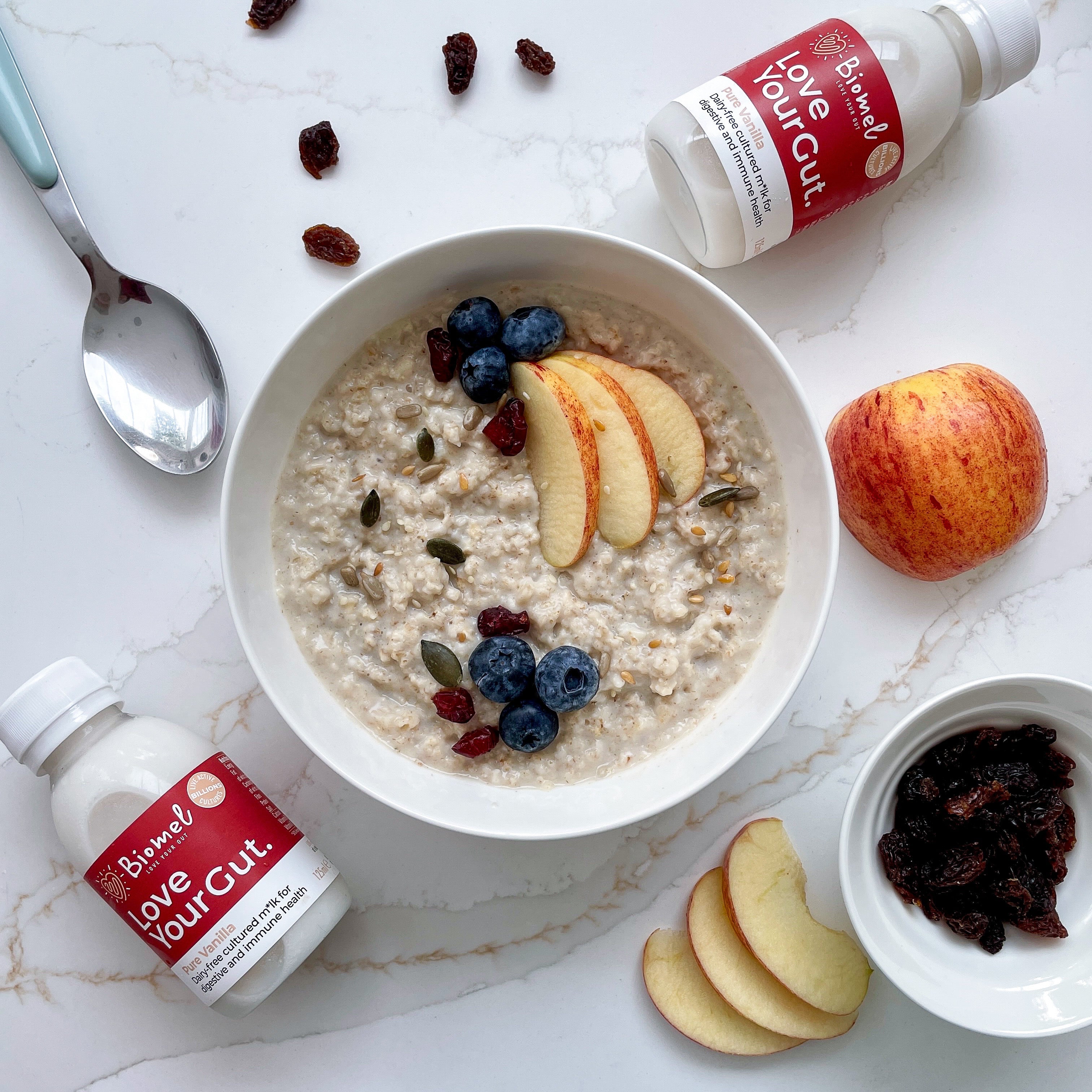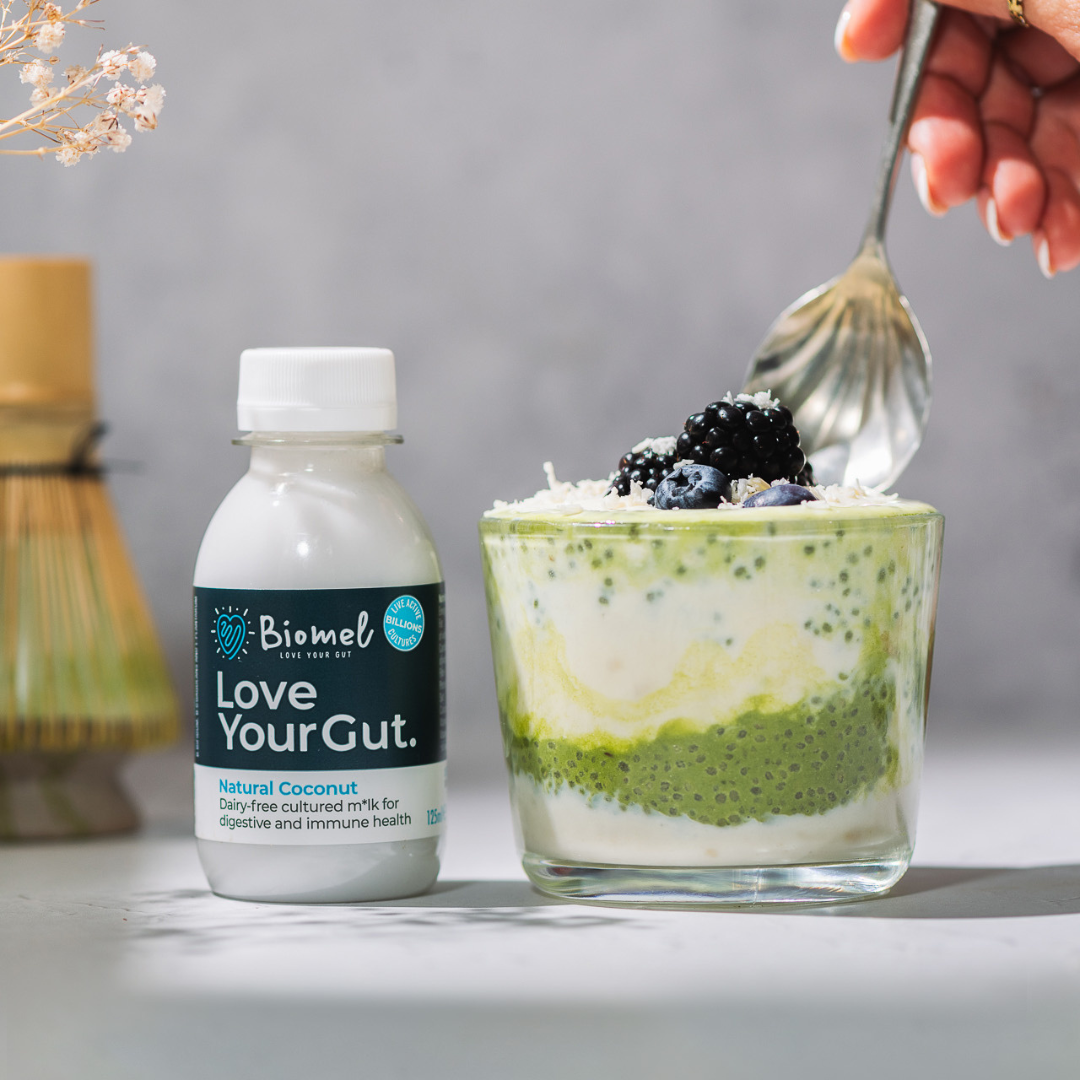Prebiotic fibre & gut health – everything you need to know

Your gut health and prebiotic fibre
If you’re looking for ways to support your gut health, then increasing your dietary fibre and prebiotic intake is a great place to start. We’ve developed a range of delicious products to help you!
In this article we will take you through what dietary fibre and prebiotics are, how they help your gut health and how to include more in your diet.
We talk a lot about probiotics, but if you’re really brushed up on your gut health than you’ll also have heard about prebiotics.
Prebiotics are a type of dietary fibre that humans cannot digest. They play a vital role in your digestive health by feeding the trillions of live beneficial bacteria (known as probiotics) that live in your gut. They act as a fertiliser for the microbes, fuelling their growth, diversity and activity. 1
The three types of prebiotics that are found in the food we eat are called inulin, fructooligosaccharides (FOS) and galacto-oligosaccharides (GOS). Foods that are naturally high in prebiotics include Jerusalem artichokes, onions, wholegrains, legumes and nuts & seeds.
Dietary fibres are plant-based ingredients that humans also cannot digest or absorb. Unlike fats, proteins, and carbohydrates which your body breaks down and absorbs, dietary fibre increases the bulk of stool, helps promote regular bowel movements and reduce the risk of constipation. 2
Fibre and Prebiotics are not the same
Not all fibres are prebiotic. Although both are non-digestible, they have slightly different functions in promoting gut health.
Fibre acts as a natural bulking to produce softer, bulkier stools and help regulate bowel movements.
Instead, prebiotics are consumed by the friendly bacteria (probiotics) in the gut. This process produces short chain fatty acids (SCFAs) which play an important role in maintaining the integrity of the gut lining, contributing to a functioning immune system and so much more.3
Although most prebiotics can be classified as dietary fibre not all fibre are prebiotics.4
Prebiotic fibre helps gut health
Prebiotic fibre is one of the key building blocks for optimum gut health. As well as increasing our good bacteria, we also need to provide an environment where probiotics can thrive in our gut.
This is where Biomel Prebiotic Fibre+ come in handy. The diversity of our six unique prebiotic fibres nourishes a different type of probiotic strain, so the more types you eat, the more diverse your gut microbiome is and the less chance for harmful bacteria to grow.
For example, chicory root fibre has been widely studied to stimulate the growth of Bifidobacterium bifidum, a beneficial bacteria found to improve bloating and prevent infections.5
The best prebiotics for gut health
Prebiotics are naturally present in a wide range of plant-based foods such as chicory root, Jerusalem artichokes, onions, wholegrains, and legumes.
We have isolated some of the best prebiotic fibres from prebiotic foods into one simple pouch to make having your daily intake of fibre and prebiotics super easy and delicious. Your gut will love you for it!
Fibre can be good for IBS
People who are experiencing IBS symptoms may be recommended to follow a Low FODMAP diet. This restricts the number of Fermentable Oligosaccharides, Disaccharides, Monosaccharides and Polyols (FODMAPs) in your diet, because the small intestine sometimes struggles to absorb them.6 Cutting out these foods however can really limit the amount of fibre in your diet.
Therefore, it is still important to be able to find a way to continue to meet your recommended daily intake of fibre if you have IBS, to fuel your gut microbiome powerhouse.
LOVE YOUR GUT TIP: You may see the terms gut microbiome, gut microbiota and gut flora used interchangeably. They all mean slightly different things, but generally refer to everything that lives in your gut, including beneficial gut bacteria, prebiotics and genetic material.
That’s why we have created prebiotic fibres that are also suitable for people following the Low FODMAP diet or for those with sensitive digestive systems. Biomel Low FODMAP Fibre+ contains a blend of gentle prebiotic fibres such as gluten-free oats, apple fibre, rice bran, guar fibre and soluble corn fibre alongside key digestive enzymes that help give your gut a helping hand to break down your food and reduce painful digestive symptoms.
Our Low FODMAP Fibre+ is a great way to benefit from prebiotics effectiveness even if you have IBS.
How much fibre should I have each day?
Probably much more then you’re getting currently. The UK government guidelines recommends adults need at least 30 grams of dietary fibre. Yet most people in the UK do not eat enough fibre. In fact, a recent national diet and nutrition survey (NDNS) suggests that only 10% of UK adults are achieving their recommended daily fibre intake.7
Easy ways to increase daily fibre intake
Life has got even busier since lockdown restrictions have eased, so we need to find an easier way to get in our recommended daily intake of fibre.
Biomel Prebiotic Fibre’s contains almost 5 g of fibre per serving – the same amount of fibre as two slices of wholemeal bread. This means by adding one serving to your morning porridge and one serving with over your afternoon yogurt, you will have already met 50% of your RDI of fibre.
Instead of making overhaul of your diet – which can be overwhelming – it’s often easier to make small habitual changes to the foods you already eat. This way, you can make a lasting impact on your health, with minimal effort. So, to help we’ve highlighted several key store cupboard foods that are naturally high in fibre and have incorporated them into your daily meals, snacks, and drinks so that you don’t have to.
Fabulous Fibre Breakfast
½ cup of oats (this contains 4g of fibre)
350 ml m*lk or water, or a mixture of the two
One sliced banana (1g)
Topped with one serving of Biomel Prebiotic Fibre+ (4.7g)
Fibre Loaded Lunch
A baked sweet potato cut in half with the skin on (4g) topped with half a can of drained chickpeas (8.3g), 1 avocado (3g), ½ lemon juice, salt, and pepper.
Fibre Fun Dinner
Mixed vegetable curry cooked with onions and spices (3.3g) with wholegrain rice (2.8g).
Fibre Fuel Snacks
A handful of nuts (3.5g) or your favourite yogurt topped with a serving of Biomel Prebiotic Fibre+ (4.7g).
Fibre-Loving Drinks
Your favourite smoothie or m*lk blended with a serving of Biomel Complete Gut Powder (4.7g).
Total fibre intake: 38g
Replacing small changes in your daily eating habits will quickly increase your fibre intake. Here are our top swaps, some are also recommended by the NHS8:
- Swap from white to wholegrain bread
- Add Biomel Complete Gut to your protein shakes
- Keep the skin on your vegetables (not forgetting to wash them)
- Add cooked pulses like beans, lentils or chickpeas to curries and salad
- Sprinkle Biomel Prebiotic Fibre+ over your morning cereal
Fibre can help sleep
Recent research has shown that a higher intake of fibre is associated with a deeper and more restorative sleep.9 Therefore, it is possible that a diet rich in prebiotic fibre may be a useful tool to improve sleep in individuals who suffer from poor sleep. We shouldn’t have to remind you of the importance of enough sleep, but another reason is that our gut microbes also love it when we sleep as they have time to rest and recover.10
Soluble and Insoluble Fibre
Dietary fibre can be divided into two main groups: soluble and insoluble fibre. The solubility refers to how they behave in the digestive system.
Soluble fibre: such as oats, chicory root, beans, and lentils absorb water to form a gel, bringing water into the digestive system, which can soften stools and help with constipation.
Insoluble fibre: such as seeds, whole grains and skins on fruits and vegetables – bulk out stools and helps keep things moving through the stomach and gut.
Gas and Fibre
When switching from a low-fibre diet to a high-fibre diet some people experience more than usual ‘wind’ or flatulence. This is the result of additional gas being produced as the fibre is broken down by your gut microbes.
We recommend you introduce high-fibre foods to your diet gradually over a few weeks as this will give your gut microbes time to adapt to a greater quantity of fibre arriving in the colon.
Why we love fibre
Genetics play a relatively minor role in shaping our gut microbiome. Your dietary choice have such a powerful influence on our gut health through a range of lifestyle choices.11
Recent research has shown that diets high in fibre from a diverse range of plant-based sources are linked with greater gut microbiome diversity which is a well-agreed marker of a healthy gut and overall health & well-being within the scientific community.12
It also has been shown that a high fibre diet can reduce the risk of type 2 diabetes, heart disease, colorectal cancer, and many other health benefits.13
Your gut is at the heart of your health and making sure you have enough fibre in your diet is a great way to look after it.
Trusted Sources
[1] https://www.ncbi.nlm.nih.gov/pmc/articles/PMC6463098/
[3] https://isappscience.org/infographic-fiber-prebiotics/
[4] https://www.ncbi.nlm.nih.gov/pmc/articles/PMC3705355/
[5] https://www.ncbi.nlm.nih.gov/pmc/articles/PMC3705355/
[6] https://onlinelibrary.wiley.com/doi/full/10.1111/j.1440-1746.2009.06149.x
[8] https://www.nhs.uk/live-well/eat-well/how-to-get-more-fibre-into-your-diet/
[9] https://www.ncbi.nlm.nih.gov/pmc/articles/PMC4702189/
[10] https://www.nature.com/articles/s41467-021-22097-0
[11] https://www.ncbi.nlm.nih.gov/pmc/articles/PMC3705355/
[12] https://www.ncbi.nlm.nih.gov/pmc/articles/PMC3577372/
[13] https://www.thelancet.com/article/S0140-6736(18)31809-9/fulltext



